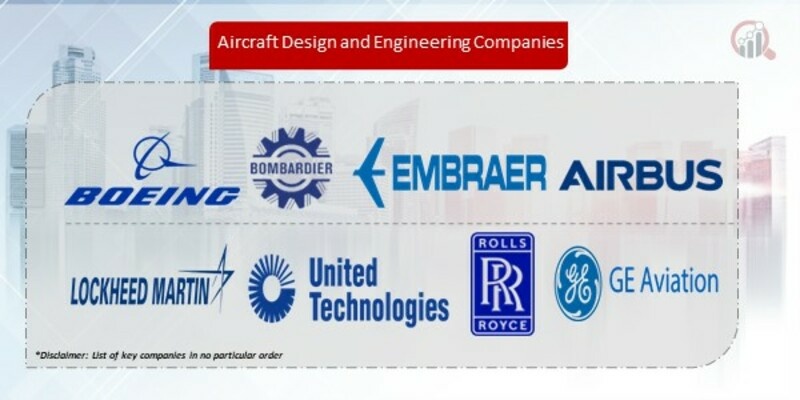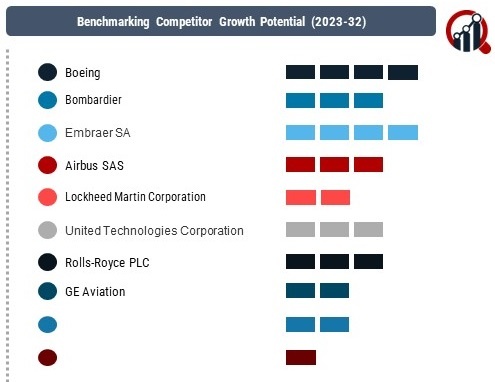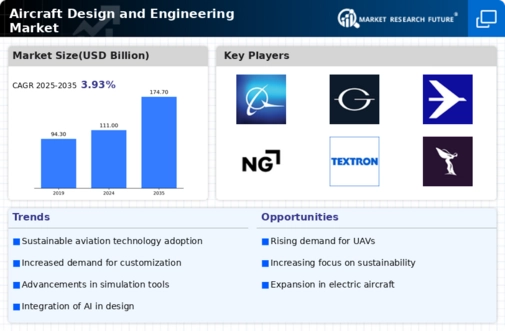Top Industry Leaders in the Aircraft Design Engineering Market

Key Players and Established Giants
At the forefront of the Aircraft Design and Engineering market stand key players with decades of experience and a robust track record.
- Boeing (US)
- Bombardier (Canada)
- Embraer SA (Brazil)
- Airbus SAS (Netherlands)
- Lockheed Martin Corporation (US) United Technologies Corporation (US)
- Rolls-Royce PLC (UK)
- and GE Aviation (US)
Strategies Adopted by Industry Leaders
The strategies adopted by these industry leaders are multifaceted, encompassing technological innovation, strategic partnerships, and a keen focus on market trends. Boeing, for instance, has been investing heavily in research and development to create more fuel-efficient and technologically advanced aircraft. Airbus, on the other hand, has strategically collaborated with suppliers and governments to strengthen its supply chain and enhance production efficiency. Lockheed Martin's diversification into emerging areas like space technology showcases a strategic move to mitigate risks and tap into new revenue streams. These players also actively engage in mergers and acquisitions to bolster their capabilities, expand market reach, and stay ahead in the competitive race.
Factors for Market Share Analysis
Market share analysis in the Aircraft Design and Engineering sector is influenced by various factors, including technological innovation, cost-efficiency, regulatory compliance, and customer satisfaction. The ability to deliver cutting-edge solutions that address market needs while adhering to stringent safety standards plays a pivotal role. Timely execution of projects, effective supply chain management, and a global presence are critical for securing and expanding market share. Additionally, the ability to adapt to evolving environmental and sustainability standards is becoming increasingly important as the industry navigates towards greener solutions.
New and Emerging Companies
While established players dominate the market, the emergence of new and agile companies injects dynamism and innovation. Embraer, a Brazilian aerospace company, has steadily gained recognition for its regional and executive jets. The emphasis on regional connectivity and cost-effectiveness has fueled Embraer's growth, positioning it as a noteworthy competitor. COMAC (Commercial Aircraft Corporation of China) is another emerging player, reflecting China's ambitions in the aerospace sector. With the development of the C919, China's first domestically produced narrow-body aircraft, COMAC aims to challenge the duopoly of Boeing and Airbus in the commercial aviation market.
Industry News and Technological Advancements
The Aircraft Design and Engineering sector is marked by rapid technological advancements and groundbreaking innovations. Industry news often revolves around the unveiling of new aircraft models, successful test flights, and breakthroughs in materials and manufacturing processes. Electric propulsion systems, advanced avionics, and artificial intelligence applications are becoming focal points for innovation. Boeing's foray into autonomous flight and Airbus's exploration of hydrogen propulsion are indicative of the industry's commitment to shaping the future of aviation. Keeping abreast of these developments is crucial for companies seeking a competitive edge.
Current Company Investment Trends
Investment trends in the Aircraft Design and Engineering market reflect the industry's strategic priorities. Increasingly, companies are directing investments towards sustainability initiatives, with a focus on developing eco-friendly and energy-efficient aircraft. Research and development budgets are expanding to explore alternative propulsion systems, lightweight materials, and advanced avionics. Cybersecurity is also emerging as a critical investment area, considering the growing reliance on digital technologies in modern aircraft. Additionally, partnerships and collaborations with startups and technology firms are on the rise, as established players seek to harness external innovation to stay at the forefront of the market.
Overall Competitive Scenario
The overall competitive scenario in the Aircraft Design and Engineering market is characterized by a delicate balance between established giants defending their market share and emerging players striving to disrupt the status quo. While companies like Boeing and Airbus continue to lead the market with their scale and experience, the entry of new players from regions like China and Brazil signals a shifting landscape. The industry's response to challenges such as the COVID-19 pandemic, which severely impacted global air travel, has also influenced the competitive dynamics. Companies that displayed resilience through strategic diversification and cost optimization strategies have emerged stronger, showcasing the importance of adaptability in this fiercely competitive arena.
In conclusion, the Aircraft Design and Engineering market is a dynamic and evolving space where innovation, strategic partnerships, and adaptability are paramount. Established players wield their experience and resources to push the boundaries of technology, while new entrants bring fresh perspectives and disrupt conventional norms. As the industry continues to navigate challenges and opportunities, the interplay of market forces, technological advancements, and strategic decisions will shape the competitive landscape for years to come.
Recent News :
Companies like Boeing, Airbus, and Lockheed Martin dominate this landscape, leveraging their extensive resources, technological expertise, and global reach. Boeing, a stalwart in the industry, has been a trendsetter in commercial and military aircraft design, continuously pushing the boundaries of innovation. Similarly, Airbus, a European giant, remains a formidable competitor, especially with its focus on fuel-efficient and environmentally sustainable aircraft. Lockheed Martin's prowess in militarTop of Form
Embraer:
- Partnership with Collins Aerospace on the E195-F cargo aircraft program: This collaboration brings together Embraer's regional jet expertise with Collins' cargo conversion experience to create a fuel-efficient and cost-effective freighter solution.
- Developing the EVE eVTOL aircraft for urban air mobility: Embraer ventures into the future of transportation with its electric vertical take-off and landing aircraft, targeting urban passenger transport and logistics applications.
- Focus on sustainable technologies and materials: Embraer explores the use of biofuels and lightweight composites in its aircraft designs to reduce their environmental impact.










